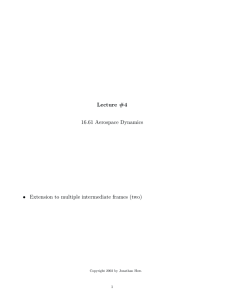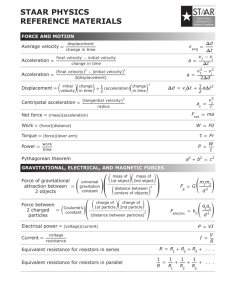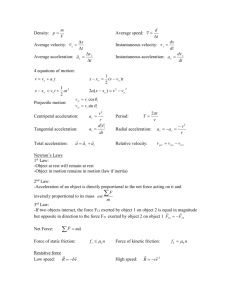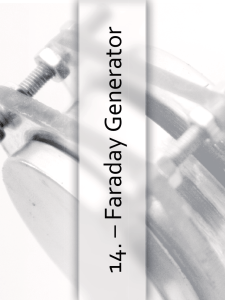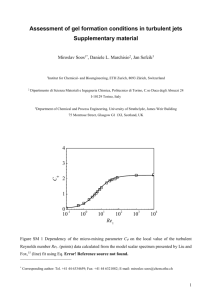section II
advertisement
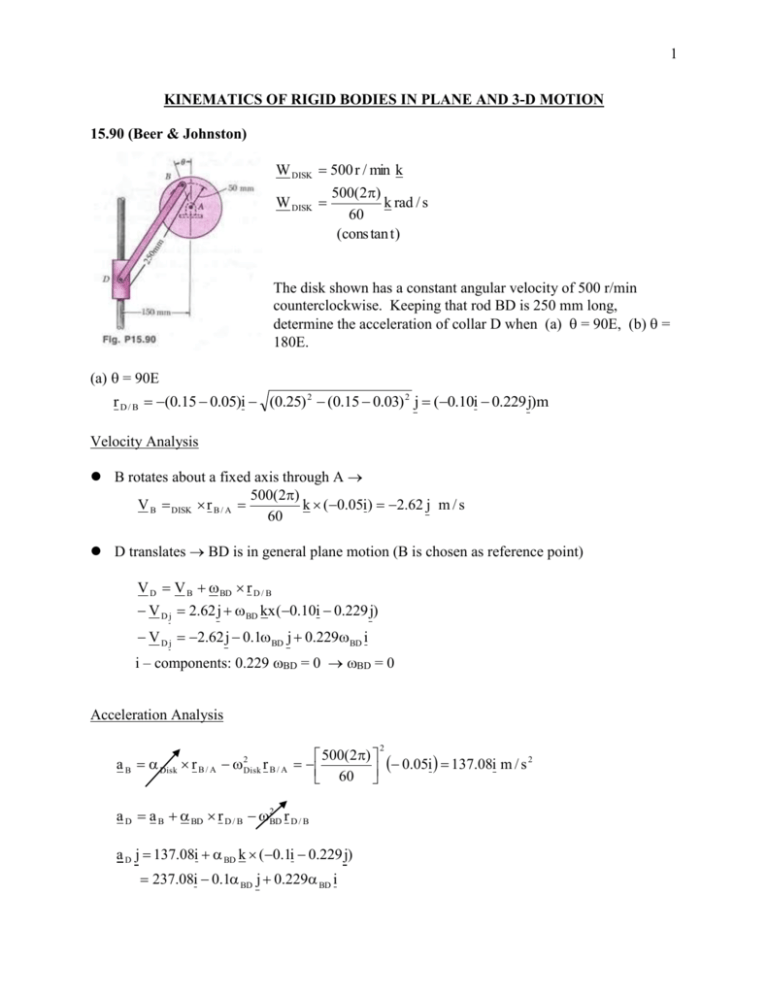
1 KINEMATICS OF RIGID BODIES IN PLANE AND 3-D MOTION 15.90 (Beer & Johnston) W DISK 500 r / min k W DISK 500(2) k rad / s 60 (cons tan t ) The disk shown has a constant angular velocity of 500 r/min counterclockwise. Keeping that rod BD is 250 mm long, determine the acceleration of collar D when (a) = 90, (b) = 180. (a) = 90 r D / B (0.15 0.05)i (0.25) 2 (0.15 0.03) 2 j (0.10i 0.229 j)m Velocity Analysis B rotates about a fixed axis through A 500(2) V B DISK r B / A k (0.05i) 2.62 j m / s 60 D translates BD is in general plane motion (B is chosen as reference point) V D V B BD r D / B V D j 2.62 j BD kx (0.10i 0.229 j) V D j 2.62 j 0.1 BD j 0.229 BD i i – components: 0.229 BD = 0 BD = 0 Acceleration Analysis 500(2) 0.05i 137.08i m / s 2 60 2 a B Disk r B / A 2 Disk B / A r a D a B BD r D / B 2BD r D / B a D j 137.08i BD k (0.1i 0.229 j) 237.08i 0.1 BD j 0.229 BD i 2 i-components: 137.08 + 0.229BD = 0 BD = 137.08 = -598.6 rad/s2 0.229 2 j-components: aD = 0.1BD = -0.1 (-598.6) = 59.9 m/s2 a D 59.9 j m / s Vector Polygon aD/Bt aD 0.1BDj Not to scale! aB 0.2299BDi b) = 180 r D / B 0.15i (0.25) 2 (0.15) 2 j (0.15i 0.2 j)m Velocity Analysis 500(2) k (0.05 j) 2.62i m / s 2 60 V B Disk r B / A V D V B BD r D / B VD j 2.62i BD k (0.15i 0.2 j) VD j 2.62i 0.15 BD j 0.2 BD i i-components: 2.62 + 0.2 BD = 0 BD = 2.62 = -13.1 rad/s 0 .2 Acceleration Analysis 500(2) a B Disk r B / A 2Disk r B / A (0.05 j) 137.08 j m / s 2 60 2 a D a B BD r D / B BD r D / B 2 a D j 137.08 j BD k (0.15i 0.2 j) (13.1) 2 (0.15i 0.2 j) 137.08 j 0.15 BD j 0.2 BD i 25.74i 34.32 j 3 25.74 = -128.7 rad/s2 0 .2 2 j-components: aD = 137.08 – 0.15BD + 34.32 = 190.7 m/s2 a D 190.7 j m / s i-components: 0 = 0.2BD + 25.74 BD = Vector Polygon aD/Bn 35.32i 25.74 i 0.15BDj 0.2BDi aD/Bt Not to scale! aB aD Example: In the four-bar linkage shown, control link OA has a counterclockwise angular velocity 0 = 10 rad/s during a short interval of motion. When link CB passes the vertical position shown, point A has coordinates x = -60 mm and y = 80 mm. Determine, by means of vector algebra, the angular velocity of AB and BC. Link AO is in rotation about a fixed axis through 0 V A o r A / O 10k (60i 80 j) 600 j 800i 100(8i 6 j) mm / s Link CB is in rotation about a fixed axis through C V B BC r B / C BC k 180 j 180 BC i mm / s Link AB is in general plane motion V B V A AB r B / A 180 BC i 100(8i 6 j) AB k (240i 100 j) 180 BC i 800i 600 j 240 AB j 100 AB i j-components: 0 = -600 + 240AB 4 AB 2.5k rad / s 2.5 rad / s AB = 600/240 = 2.5 rad/s i-components: -180WBC = -800 - 100AB 180BC = 800 + 100(2.5) BC = 1050/180 = 5.83 rod/s BC 5.83k rad / s 5.83 rad / s 15.93 A aC/An 0.15m aB/An B aC/At 0.075m j 60(2) (k ) rad / s 60 2k rad / s (cons tan t ) AB VB/At i aB/At AB rotates with a constant angular velocity of 60 r/min clockwise. Knowing that gear A does not rotate, determine the acceleration of the tooth of gear B which is in contact with gear A. Velocity Analysis B rotates about a fixed axis through A V B AB r B / A 2k 0.225 j 1.414i m / s Gear A does not rotate V C 0 C is the instantaneous center of rotation of gear B V 1.414 B B 18.85 rad / s (clockwise ) rB / C 0.075 Acceleration Analysis a B AB r B / A 2AB r B / A (2) 2 (0.225 j) 8.88 j a C a B a B r C / B 2B r C / B 8.88 j (18.85) 2 (0.075 j) 8.88 j 26.65 j a C 17.77 j 5 Note: Gear B is in general plane motion; B is chosen as reference point. Vector Polygon aC aC/Bn Not to scale! aB/An RATE OF CHANGE OF A VECTOR WITH RESPECT TO A ROTATINT FRAME OF REFERENCE Y A Y1 IA/B IA X1 B IB X XY frame is fixed xy frame rotates with angular velocity about he z-axis (i.e. perpendicular to plane of screen) r A r B r A / B rB i x j y i, j not fixed since xy rotating. r A r B i x j y x Evaluation of dj di and dt dt dj di y dt dt 6 di/dt = jd/dt dj/dt = -id/dt j i d d di = j d di = (1) d Introduce cross-product j dk k k 0 dt i k d di i dt dt d d j k j i i j dt dt k i j j r A r B rx jy ix jy r B r A / B r A / B d r A XY d r B XY d r A xy r A xy dt dt dt Generalization For any vector A dA dA A dt XY dt xy Background |dA|XY X11 Y |dA|x1y1 Y1 Ad dA=d(|A|) Y11 dA d X1 Ad X 7 Vector A swings to A1 in time dt observer attached to frame xy (i.e. rotating frame) sees that dA consists of two components. dt xy - A dB/dt due to rotation of A through d/B in xy. - dA/dt due to change in magnitude of A. Part of absolute rate of change is A not seen by rotating observer is A A is magnitude of vector A. Plan motion in a rotating frame VA VB r A / B VA / B Acceleration r A / B r A / B V aA aB A/B V A / B ix jy dj di V x y A / B ix jy dt dt a A / B ix jy a A/ B VA/ B rA/B rA/B dA dA recall A dt fixed dt rot d A . dt 8 rA/B d ix jy) dt dj di ix jy x y dt dt VA / B r A / B a A a B r A / B x( r A / B ) 2 V A / B a A / B Y y1 A tangential acceleration due to angular acceleration of rotating frame x1 B normal or centripetal acceleration due to rotation of rotating frame X 2VAB – CORIOLIS ACCELERATION a P a A Y r P / A y (y r P / A ) 2y V P / A a P / A a A Y r A / O y (y r A / O ) a A 15 j (15 j 3i) y (y r P / A ) 15 j (15 j 1j) V P / A A r P / A 45i 1j 2y V P / A 2(15 j) (45i 1 j) a P / A A r P / A A A r P / A 45i 45i 1j A A r A / IC 9 Consider a rotating disk with a radial slot A small particle A is confined to slide in the slot Let = constant and Vrel = constant The velocity of A has two components: x (due to rotation of the disk) vrel (due to motion of A in the slot) Consider the rate of change of the velocity of A: - no change in magnitude of Vrel since Vrel = constant. - change in direction of Vrel is x d - change in magnitude of x is dx - change in direction of x is xd Rates of change are: x x d dx , dt dt and x d dt d dx and are in the (+) y-direction dt dt x d is in the (-) x-direction dt Total rate of change of VA: a A x x j x 2 i x2 i 2x j (normal) (Coriolis) a rel 0 since Vrel = constant and slot has no curvature r A / O 0 since is constant w 10 XY : Fixed Frame xy : Rotating Frame Recall for a fixed frame: V A V B V A / B Now for a rotating frame: V A / B V rel r A / B V A V B r A / B V rel V A V B V P / B V A/ P VA VP V A/ P V A V B V A/ B XY : Fixed Frame Xy : Rotating Frame ( r A / B ) : normal acceleration of a point (P) fixed in the rotating frame r A / B : tangential acceleration of a point (P) fixed in the rotating frame a rel : acceleration of point A in the rotating frame 2 V rel : Coriolis acceleration brought about by the rotating () of the rotating frame and relative motion (Vrel) in the rotating frame 11 15.119 The motion of pin P is guided by slots cut in rods AE and BD. Knowing that the rods rotate with the constant angular velocity A = 4 rad/s ↓ and B = 5 rad/s ↓, determine the velocity of pin P for the position shown. Pin P moves in BD and AE both of which rotate relative motion in a rotating frame V P V A A r P / A V P / AE (for AE) 0.25 i VP / AE (i) V P 4(k ) cos30 V P (1.1547 j VP / AE i) m / s V P V B B r P / B V P / BD (for BD) 5(k ) (0.25 tan 30)( j*) VP / BD ( j*) (0.722i * VP / BD j*) m / s Equateand 1.1547 j VP / AE i 0.722i * VP / BD j * Coordinate transformation: j* i* i cos 30 j sin 30 j 30o 30o j* i sin 30 j cos 30 i* i 1.1547 j VP / AE i 0.722 i cos 30 j sin 30 VP / BD (i sin 30 j cos 30) j(1.1547 0.722 sin 30 VP / BD cos 30) i(VP / AE 0.722 cos 30 VP / BD sin 30) j-component: -1.1547 + 0.722 sin 30 + VP/BD cos 30 = 0 1.1547 0.722 sin 30 0.916 m / s cos 30 i-components: -VP/AE + 0.722 cos 30 - VP/BD sin 30 = 0 VP / BD VP / AE 0.722 cos 30 0.916 sin 30 0.167 m / s V P (1.155 j 0.167i) m / s Vp -0.167i -1.155j 12 or V P 0.722i * 0.916 j * m / s Vp -0.916j* -0.722i* 15.123 At the instant shown the length of the boom is being decreased at the constant rate of 150 mm/s and the boom is being lowered at the constant rate of 0.075 rad/s. Knowing that = 30, determine (a) the velocity, (b) the acceleration of point B. There is relative motion of B in the rotating x-y frame (a) V B V A r B / A V Brel A is fixed V B (0.075)(k) 6i 0.15i V B (0.45 j 0.15i) m / s (b) a B a A a r B / A 2 r B / A 2 V B rel a B rel -0.45j VB -0.15i ( is cons tan t ) (VBrel is cons tan t ) a B (0.075) (6i) 2(0.075)(k) 0.15(i) 2 a B (0.034i 0.023 j m / s 2 -0.034i 0.023j aB The vertical shaft and attached clevis rotate about the zaxis at the constant rate = 4 rad/s. Simultaneously, the shaft B revolves about its axis OA at the constant rate 0 = 3 rad/s, and the angle is decreasing at the constant rate of /4 rad/s. Determine the angular velocity and the magnitude of the angular acceleration of shaft B when = 30. The x-y-z axes are attached to the clevis and rotate with it. k o cos j o sin k i 4k 3(0.866) j 3(0.5)k i 4 (2.5k 2.898 j 0.78i) rad / s 13 d k k o cos j o ( sin ) j o cos j o sin k o (cos ) k o sin k i i () dt k o sin j o cos j o cos k o sin k i i i , j j , k k i (o sin )i (o cos ) j o cos k ( i) o sin j o cos ( j) o cos k ( j) o sin j o cos i) o cos k (4) j 3 sin 30 j (3)( 4) cos 30i 3 cos 30k 4 4 4 11.44 m / s 2 1. The circular plate and rod are rigidly connected and rotate about the ball-and-socket joint ( ) with an angular velocity = i + j + k. Knowing that VA = -(540 mm/s)i + 350 mm/s)j + (r4)2k and ij = 4 rad/s. Determine (a) the angular velocity of the assembly, (b) the velocity of point B. 2. A disk of radius r rotates at a constant rate 2 with respect to the are ( ), which itself rotates at a constant rate 1 about the Y axis. Determine (a) the angular velocity and angular acceleration of the disk, (b) the velocity and acceleration of point A on the rim of the disk. 14 3. The bent rod ABC rotates at a constant rate 1. Knowing that the collar D moves downward along the rod at a constant relative speed u, determine for the position shown (a) the velocity of D, (b) the acceleration of D. 4. A disk of radius r spins at the constant rate 2 about an axle held by a fork-ended horizontal rod which rotates at the constant rate 1. Determine the acceleration of point I for an arbitrary value of the angle .
